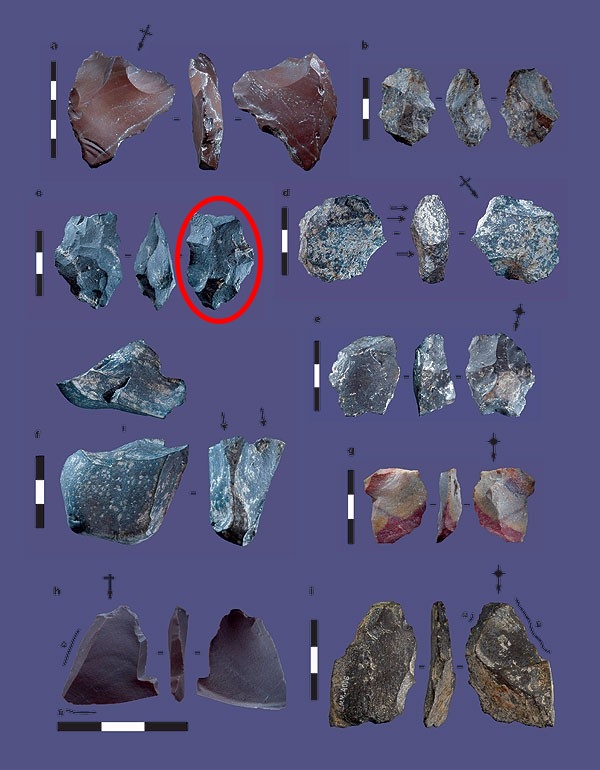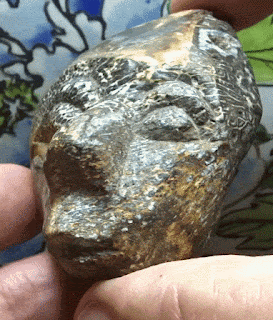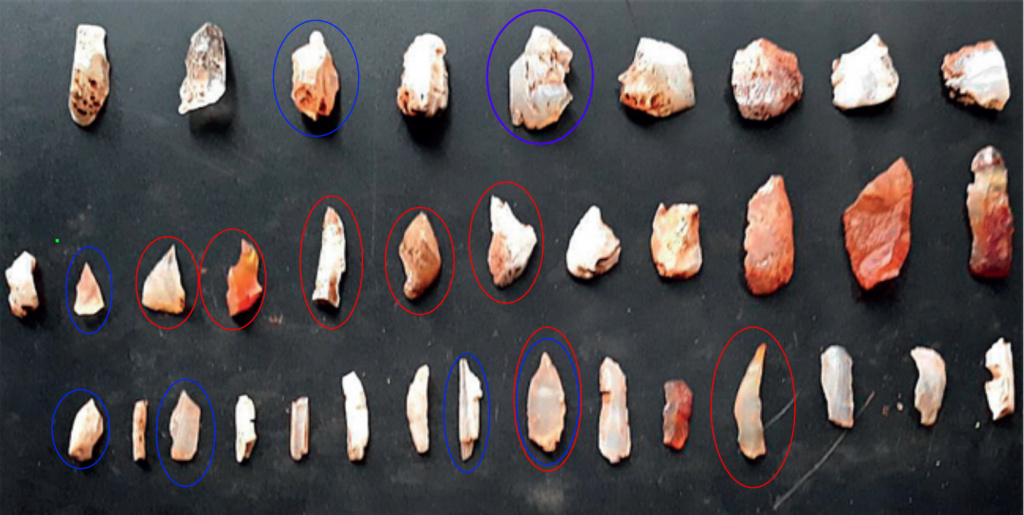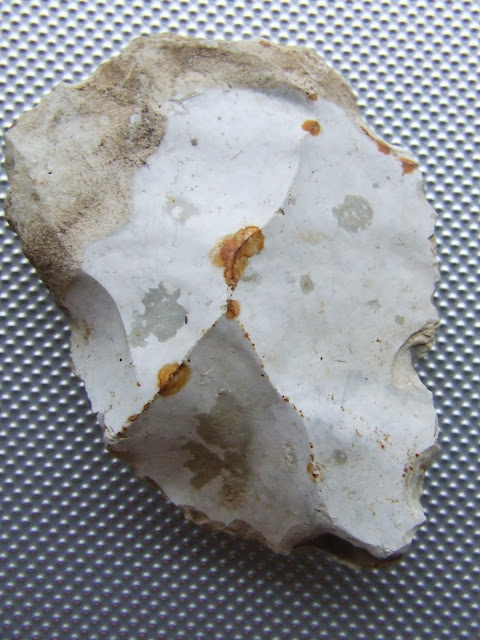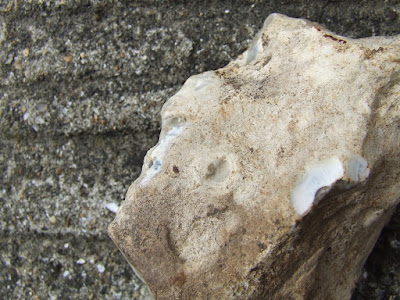There are many ways in which we can look at an object and recognize that an intelligence was used to modify it, this I have termed 'Evidence of Cognition'. Eoliths and many other finds have been dismissed as the product of natural factors, tide wave action, falls, trampling etc, but with no actual evidence at all! or even a real scientific explanation. So some archaeologists are literally telling you the 'moon is made of cheese', and not even giving you any evidence for their 'giant imaginary space cow'.
Let's think about this for flints and recognizing evidence of cognition in them, when flints are formed they are covered in cortex, finding a flint without cortex would suggest the cortex was removed somehow, to remove all of the cortex would require a lot of action, rather like peeling the skin from a potato, although obviously percussion with respect to flints. Symmetry and parallel features in flint finds also hint at mathematics in use, hence evidence of cognition again. Also repeating patterns on the surface of the flint would indicate the same strengths and techniques and precision were used to remove flakes. Long flake removals that produce linear parallel scaring are absolute proof of agency and evidence of cognition, the probability when examining the forces involved is so close to impossible just for two parallel flake removals. Also the patinas in flint can give an indication that the flakes removed from the flint could have happened in proximal time periods, and none since, as it's possible to see the difference in old chips and new chips. Repeating topologies in finds, the shapes found also give an indication of design, so again evidence of cognition.
Evidence of Cognition in Flint Finds: Identifying Agency in Archaeological Artifacts
Introduction: The identification of flint artifacts as products of human agency and cognition has long been a topic of debate in the field of palaeoanthropology and archaeology. Identifying human agency and cognition is important for understanding the evolution of human behaviour and technology. While some researchers have dismissed certain flint finds as natural formations, many studies have shown that the evidence of cognition in flint artifacts is significant and cannot be ignored. In this paper, we examine the various factors that contribute to the identification of flint artifacts as products of human agency and cognition, including symmetry, parallel features, patina, flake removal, and repeating patterns, and topologies in shape and form, figuration (creature and other depictions).
While the identification of some flint artifacts as tools is straightforward, the recognition of more subtle features requires careful analysis. In this paper, we examine the role of evidence of cognition in identifying flint artifacts, focusing on the factors that indicate that flint artifacts are the result of human agency and cognition.
Flint is a common material used by early humans for tool-making, and as such, flint finds can provide valuable insights into the cognitive abilities of our prehistoric ancestors. Identifying evidence of cognition in flint finds can be a challenging task, but there are several key characteristics to look for that can indicate the use of intelligence and agency in the creation of these artifacts.
One way to recognize the use of intelligence in modifying an object is to look for evidence of precision or purposeful design. If an object has been modified in a way that seems to serve a specific purpose, it is more likely that an intelligent being was involved in the modification process.
Another way to recognize evidence of cognition is to look for patterns or repetitions. If an object has been modified in a consistent and repetitive manner, it is more likely that an intelligent being was involved in the modification process.
Additionally, examining the use of raw materials and tools can also provide evidence of cognition. If an object has been made from a material that is not readily available in the surrounding environment, or if it has been shaped using a tool that is not found in the area, it suggests that an intelligent being had to bring these materials or tools to the site in order to create the object. An example of this could be the use of manufactured pigments, or ochre line etching done by a sustained and applied force from iron pyrites.
One of the most obvious signs of agency in flint finds is the presence of flake removal scars. When flint is initially formed, it is covered in a layer of cortex that must be removed to access the usable material inside. This removal of cortex requires considerable physical action, such as percussion or pressure flaking, indicating the deliberate use of force to shape the flint. Remailing cortex is often used as a comfort or grip feature in flint tools, simply found on side surfaces opposite the cutting blade, there are many examples of this in indisputable flint tool finds.
Shape topologies: The identified shapes in flint tool assemblages, such as hand axes and arrowheads, are clear evidence of design and cognition. The precision and symmetry involved in creating these tools is undeniable, and the fact that we find them in large numbers and in a variety of contexts is further proof that they were created intentionally by ancient humans. The design elements and topologies in these tools show an incredible level of skill and craftsmanship, and suggest that the creators of these tools were not only able to conceive of and plan their designs, but were also able to execute them with a high level of precision.
Similarly, the figurative depictions found in figure stones are not just random patterns, but show a clear repetition of subjects such as elephants, apes, bears, and hand shapes. The fact that these subjects are framed by the edges of the flint find is further evidence that they were created intentionally by ancient humans, rather than being a product of pareidolia or random chance, there is also common convention and even common repeating combinations that prove design, skill and forethought. The level of detail and complexity in these depictions is also remarkable, and suggests that the creators of these figure stones were skilled artists who were able to create incredibly detailed and lifelike representations of the creatures they saw around them.
In summary, the identification of specific shapes and designs in flint tool assemblages and figure stones is clear evidence of design and cognition in ancient humans. The repetition of these shapes and designs across different tools and stones suggests that they were created intentionally, rather than being a product of random chance or natural formation. The skill and precision involved in creating these tools and stones is remarkable, and serves as a testament to the ingenuity and creativity of our ancient ancestors.
Evidence of Cognition in Flint Artifacts: The evidence of cognition in flint artifacts can be seen in a number of different ways. One of the most important factors is symmetry. Many flint artifacts, including tools and figurative depictions, show a high degree of symmetry, indicating that the maker was intentionally creating a balanced design. This level of symmetry is highly unlikely to occur by natural processes. Symmetry and parallel features in flint finds also suggest the use of mathematical reasoning and planning. Humans are known to have an innate sense of symmetry, and the presence of symmetrical features in flint finds suggests a deliberate attempt to create balance and order in the design.
Parallel features, such as parallel flake removal scars or linear patterns, also suggest a deliberate and planned approach to flint working. Blade sharpening, and repeating patterns are all strong indicators of human agency and cognition. The probability of two or more parallel features occurring in natural formations is extremely low, making it highly unlikely that parallel features in flint artifacts are the result of natural processes. Even two similar flake removals proximal to each other are also very good evidence for cognition, lightning has struck twice in the same locale, comparable forces have made a pair of like flake removals in a substance that is harder than steel, To do this requires cognition, find a third similar flake removal and we need something like a trillion to one chance for those three to be a natural occurrence. We could throw a flint off a cliff a billion times and never get one of those long slender flake removals found in something like a flint core, let alone a similar set of parallel flake removals.
In addition, repeating patterns on the surface of flint artifacts indicate that the same strength and techniques were used to remove flakes. These patterns are unlikely to occur in natural formations and provide further evidence of human agency and cognition. A line of flake removals, commonly seen in flint finds, is another piece of evidence pointing to agency and cognition. This type of flake removal is often seen in blade sharpening, a process where a series of small features are created at the edge to create a sharp edge for use in cutting. Flint pecking, a process where a small piece of flint or possibly even iron pyrites or diamonds are used to remove tiny flakes to create a specific feature, in a line of flake removals, commonly seen in flint finds, is another piece of evidence pointing to agency and cognition. The pattern and direction of flake removals, the size and shape of the resulting tool or figure, and the presence of patina all contribute to the overall picture of evidence of cognition in flint finds. It is therefore nonsensical to dismiss such finds as products of natural factors, without any evidence to suggest that such natural processes could even produce the observed features. Occam's Razor, a principle in science that states that the simplest explanation is often the best one, would suggest that the most likely explanation for these finds is that they were created by intelligent beings.
The probability of natural events producing the same pattern of chips consistently around the edges of a flint find is extremely low. This is because the forces involved in natural events such as weathering and erosion are random and chaotic, and they do not typically produce consistent patterns. On the other hand, deliberate flake removal produces consistent patterns of chips that are indicative of a systematic and controlled process.
In summary, identifying evidence of cognition in flint finds involves looking for signs of agency, such as deliberate flake removal scars, symmetry, parallel features, repeating patterns, and long flake removals. Additionally, the age and patina of the flint can provide valuable information on the likelihood of intentional shaping by early humans. By using these key characteristics, archaeologists can identify and better understand the cognitive abilities of our prehistoric ancestors.
Conclusion: The evidence of cognition in flint artifacts is significant and cannot be ignored. The factors of symmetry, parallel features, patina, flake removal, and repeating patterns are all strong indicators of human agency and cognition. Dismissing certain flint finds as natural formations without any evidence to suggest that this could even happen goes against the principle of Occam's razor. The scientific community must acknowledge the significance of evidence of cognition in flint artifacts and the importance of identifying flint artifacts as products of human agency and cognition.
Its a pity we cannot find any evidence of cognition in the archaeologists who dismiss such eolith finds as natural
The above finds are labelled as Eoliths found in England, France and Belgium. Clear evidence of cognition is visible here and nothing else, no natural process can produce the flake removal scars seen here and no scientist can prove or produce evidence that that is the case.











